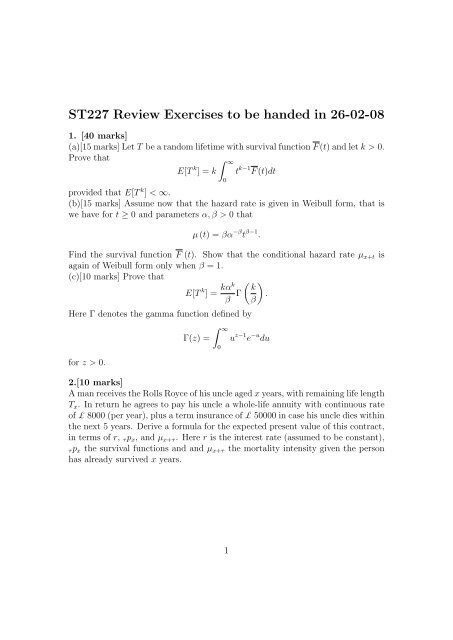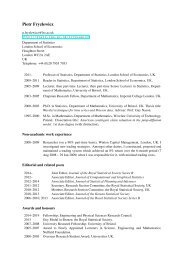ST227 Review Exercises to be handed in 26-02-08
ST227 Review Exercises to be handed in 26-02-08
ST227 Review Exercises to be handed in 26-02-08
You also want an ePaper? Increase the reach of your titles
YUMPU automatically turns print PDFs into web optimized ePapers that Google loves.
<strong>ST227</strong> <strong>Review</strong> <strong>Exercises</strong> <strong>to</strong> <strong>be</strong> <strong>handed</strong> <strong>in</strong> <strong>26</strong>-<strong>02</strong>-<strong>08</strong>1. [40 marks](a)[15 marks] Let T <strong>be</strong> a random lifetime with survival function F (t) and let k > 0.Prove thatE[T k ] = k∫ ∞0t k−1 F (t)dtprovided that E[T k ] < ∞.(b)[15 marks] Assume now that the hazard rate is given <strong>in</strong> Weibull form, that iswe have for t ≥ 0 and parameters α, β > 0 thatµ (t) = βα −β t β−1 .F<strong>in</strong>d the survival function F (t). Show that the conditional hazard rate µ x+t isaga<strong>in</strong> of Weibull form only when β = 1.(c)[10 marks] Prove that( )E[T k ] = kαk kβ Γ .βHere Γ denotes the gamma function def<strong>in</strong>ed byfor z > 0.Γ(z) =∫ ∞0u z−1 e −u du2.[10 marks]A man receives the Rolls Royce of his uncle aged x years, with rema<strong>in</strong><strong>in</strong>g life lengthT x . In return he agrees <strong>to</strong> pay his uncle a whole-life annuity with cont<strong>in</strong>uous rateof £ 8000 (per year), plus a term <strong>in</strong>surance of £ 50000 <strong>in</strong> case his uncle dies with<strong>in</strong>the next 5 years. Derive a formula for the expected present value of this contract,<strong>in</strong> terms of r, τ p x , and µ x+τ . Here r is the <strong>in</strong>terest rate (assumed <strong>to</strong> <strong>be</strong> constant),τp x the survival functions and and µ x+τ the mortality <strong>in</strong>tensity given the personhas already survived x years.1
3. [25 marks]The contract of James Bond specifies that the secret agent (resp. some of hisrelatives) will receive the <strong>be</strong>nefits of a term <strong>in</strong>surance depend<strong>in</strong>g on his cause ofdeath. If 007 dies <strong>in</strong> immediate action (state d 1 ), the <strong>be</strong>nefit is £ 100000. Onthe other hand, a natural death not related <strong>to</strong> his job (state d 2 ) will yield onlya <strong>be</strong>nefit of £ 50000. Her majesty’s secret service estimates that the transitionfrom active (state a) <strong>to</strong> d 1 happens with a certa<strong>in</strong> rate µ whereas the transitionfrom a <strong>to</strong> d 2 happens with rate ν. Moreover, James receives each time he spends<strong>in</strong> hospital (transition from a <strong>to</strong> hospital state i with rate σ, and from i <strong>to</strong> a withrate ρ) a cont<strong>in</strong>uous rate payment with <strong>be</strong>nefit rate b. Transition from i <strong>to</strong> d 2happens with rate ν ′ whereas it is assumed that it is not possible <strong>to</strong> have a directtransition from i <strong>to</strong> d 1 .(a)[5 marks] Draw a flowchart specify<strong>in</strong>g the possible states and the transitionrates.(b)[10 marks] Derive the forward differential equation for the transition probabilityp ad1 and give the <strong>in</strong>itial condition.(c)[10 marks] F<strong>in</strong>d a differential equation for the reserve <strong>in</strong> states a and i. Youmay use the general Thiele’s equations.4. [25 marks]Denote by X t a Poisson process with rate λ > 0. (Recall that a Poisson processhas state space Z = {0, 1, 2, 3, ...} and the only possible transitions are with<strong>in</strong>tensity λ from state i <strong>to</strong> state i + 1 for any i ∈ Z). As the Poisson processis a homogeneous Markov cha<strong>in</strong> (the <strong>in</strong>tensities do not depend on time) we canwrite p i,j (t) := p i,j (0, t).(a)[5 marks] Proof that for any i ∈ Zp i,i (t) = e −λt .(b) [10 marks] Prove that the forward equation is given byddt p i,j (t) = λp i,j−1 (t) − λp i,j (t) (1)for j > i ≥ 0. What is p i,j (0)?(c)[10 marks] Check that equation (1) is fulfilled byfor t > 0 and j > i ≥ 0.−λt (λt)j−ip i,j (t) = e(j − i)!2
















